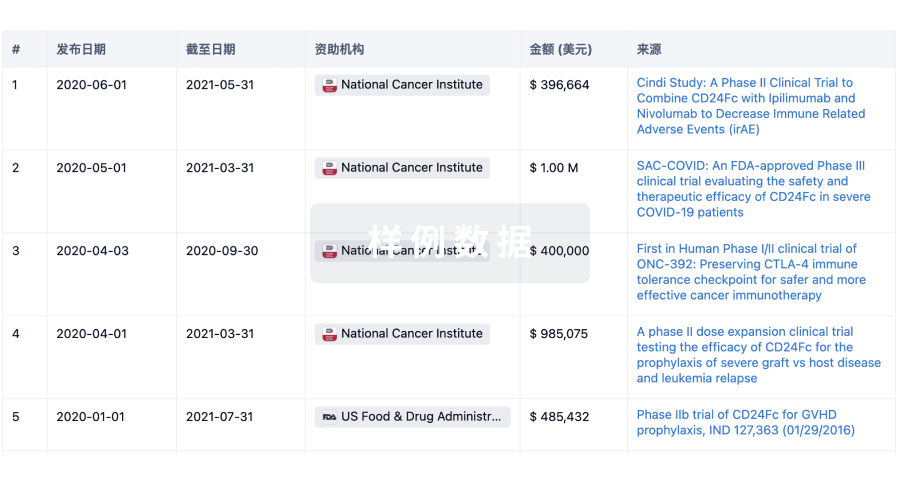预约演示
更新于:2025-05-07

Oncovir, Inc.
更新于:2025-05-07
概览
标签
免疫系统疾病
呼吸系统疾病
血液及淋巴系统疾病
聚合物
关联
2
项与 Oncovir, Inc. 相关的药物靶点- |
作用机制 免疫刺激剂 |
在研机构- |
在研适应症- |
最高研发阶段终止 |
首次获批国家/地区- |
首次获批日期- |
25
项与 Oncovir, Inc. 相关的临床试验NCT06782932
A Pilot Study Comparing Neoadjuvant and Adjuvant GVAX vs a Mutated KRAS Peptide Vaccine Given With Anti-PD-1 and Anti-CD137 for the Treatment of Surgically Resectable Pancreatic Adenocarcinoma
The purpose of this study is to determine the optimal dose of AGEN2373 that is safe when given in combination with balstilimab and Pancreatic GVAX Whole Cell Vaccine and evaluate the safety and clinical activity of balstilimab and AGEN2373 in combination with GVAX (Arm 1) or mKRASvax (Arm 2) in surgically resectable pancreatic adenocarcinoma.
开始日期2025-06-01 |
申办/合作机构 |
NCT06064279
Harnessing Allo-immunity to Enhance Immune Checkpoint Inhibitor Responses in Advanced NSCLC
Veterans with advanced lung cancer may benefit from recent advances in technologies that is designed to change the activities of their own white blood cells and help kill tumors. However, many cancers can hide from white blood cells making white blood cells less effective in killing tumors. In this study the investigators plan to boost the activity of patients white blood cell by making tumor cells more visible to the white blood cells. This will be done by injecting antibodies and a new drug that together can make white blood cells inside tumors more active. The investigators plan to recruit sixteen people with advanced lung cancer to make sure that this treatment, which has not been done in any humans, is safe and well tolerated.
开始日期2024-06-04 |
申办/合作机构 |
NCT06343077
Phase II Trial of In-Situ Autologous Vaccination With Intratumoral and Systemic Hiltonol® (Poly-ICLC) Administered to Prostate Cancer Patients on Active Surveillance
This is a partially blinded randomized controlled phase II pilot study comparing Poly-ICLC (Hiltonol®) treatment vs no treatment, for prostate cancer participants on active surveillance.
开始日期2024-01-16 |
申办/合作机构 |
100 项与 Oncovir, Inc. 相关的临床结果
登录后查看更多信息
0 项与 Oncovir, Inc. 相关的专利(医药)
登录后查看更多信息
82
项与 Oncovir, Inc. 相关的文献(医药)2024-04-05·Cancer Research
Abstract CT023: Prostate cancer in situ autovaccination with the intratumoral viral mimic poly-ICLC: Making a cold tumor hot
作者: Bhardwaj, Nina ; Wagaskar, Vinayak ; Duval, Manuel ; Padanilam, Babu ; Salazar, Andres ; Gupta, Raghav ; Garcia-barros, Monica ; Robison, Macy ; Menon, Mani ; Pedraza, Adriana ; Dovey, Zachary ; Bhatt, Kamala ; Brody, Rachel ; Haines, Kenneth ; Fatterpekar, Monali ; Pasat-karasik, Cristina ; Ratnani, Parita ; Farkas, Adam ; Davenport, Lily ; Hakansson, Alexander ; Zhang, Xiangfu ; Parekh, Sneha ; Bhardwaj, Swati ; Galsky, Matthew D. ; Gonzalez-Gugel, Elena ; Knauer, Cynthia ; Jambor, Ivan ; Davicioni, Elai ; Nair, Sujit S. ; Schlussel, Kacie ; Chakravarty, Dimple ; Rykunov, Dmitry ; Balan, Sreekumar ; Tewari, Ashutosh K. ; Gupta, Akriti ; Shaarani, Majd Al ; Thin, Tin Htwe ; Reva, Boris ; Peros, Ante ; Ellis, Ethan ; Meseck, Marcia ; Lundon, Dara ; Liu, Yang ; Weil, Rachel
2024-02-02·Neuro-Oncology
A combinatory vaccine with IMA950 plus varlilumab promotes effector memory T-cell differentiation in the peripheral blood of patients with low-grade gliomas
Article
作者: Molinaro, Annette M ; Shai, Anny ; Ogino, Hirokazu ; Butowski, Nicholas A ; Hilf, Norbert ; Watchmaker, Payal B ; Daras, Mariza ; Oberheim Bush, Nancy Ann ; Wang, Albert S ; Taylor, Jennie W ; Hervey-Jumper, Shawn L ; Okada, Hideho ; Rabbitt, Jane E ; Chang, Susan M ; Keler, Tibor ; Okada, Kaori ; Mayer-Mokler, Andrea ; Shahin, Maryam ; Phillips, Joanna J ; Tedesco, Meghan R ; Gibson, David ; Salazar, Andres M ; Berger, Mitchel S ; Perry, Arie ; Saijo, Atsuro ; Clarke, Jennifer L
2023-05-31·NPJ vaccines
ASP-2/Trans-sialidase chimeric protein induces robust protective immunity in experimental models of Chagas' disease.
Article
作者: Azevedo, Bárbara ; Junqueira, Caroline ; Ferreira, Camila P ; Salazar, Andres M ; Hojo-Souza, Natalia S ; Teixeira, Santuza R ; Brito, Rory ; Aguiar-Soares, Rodrigo D O ; Salazar, Natalia ; Castro, Julia T ; Reis, Alexandre B ; Vieira, Paula M A ; Fernandes, Ana Paula ; Cardoso, Jamille M ; Caballero, Otávia ; Gazzinelli, Ricardo T ; Valiate, Bruno ; Carneiro, Cláudia M ; Lannes-Vieira, Joseli ; Vasconcellos, Ronnie ; Toledo, Cristiane
100 项与 Oncovir, Inc. 相关的药物交易
登录后查看更多信息
100 项与 Oncovir, Inc. 相关的转化医学
登录后查看更多信息
组织架构
使用我们的机构树数据加速您的研究。
登录
或

管线布局
2025年09月05日管线快照
管线布局中药物为当前组织机构及其子机构作为药物机构进行统计,早期临床1期并入临床1期,临床1/2期并入临床2期,临床2/3期并入临床3期
临床2期
1
1
其他
登录后查看更多信息
当前项目
| 药物(靶点) | 适应症 | 全球最高研发状态 |
|---|---|---|
聚肌胞 ( TLR3 ) | 前列腺癌 更多 | 临床2期 |
MELITAC 12.1 Peptide Vaccine(University of Virginia) | 黑色素瘤 更多 | 无进展 |
登录后查看更多信息
药物交易
使用我们的药物交易数据加速您的研究。
登录
或

转化医学
使用我们的转化医学数据加速您的研究。
登录
或

营收
使用 Synapse 探索超过 36 万个组织的财务状况。
登录
或

科研基金(NIH)
访问超过 200 万项资助和基金信息,以提升您的研究之旅。
登录
或

投资
深入了解从初创企业到成熟企业的最新公司投资动态。
登录
或

融资
发掘融资趋势以验证和推进您的投资机会。
登录
或

Eureka LS:
全新生物医药AI Agent 覆盖科研全链路,让突破性发现快人一步
立即开始免费试用!
智慧芽新药情报库是智慧芽专为生命科学人士构建的基于AI的创新药情报平台,助您全方位提升您的研发与决策效率。
立即开始数据试用!
智慧芽新药库数据也通过智慧芽数据服务平台,以API或者数据包形式对外开放,助您更加充分利用智慧芽新药情报信息。
生物序列数据库
生物药研发创新
免费使用
化学结构数据库
小分子化药研发创新
免费使用


